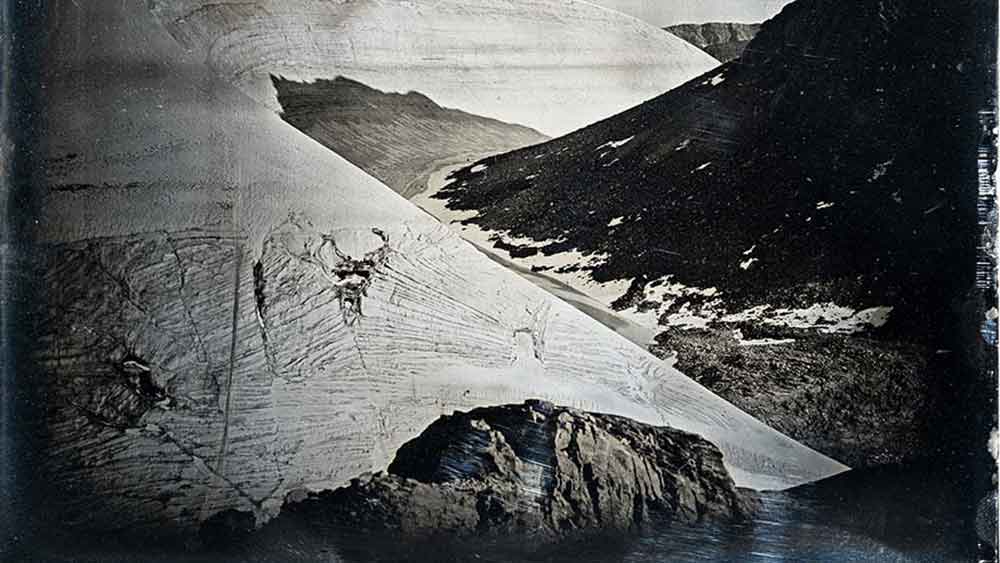Navigation auf uzh.ch
Navigation auf uzh.ch

It's springtime and the mountains still provide the iconic image we expect, with white-capped peaks and higher altitudes still firmly in the grip of ice and snow. But even though the white stuff slowly recedes as summer progresses, the great glaciers will never stop flowing. This, at least, is how it's imprinted on our collective Alpine subconscious – peaks, glaciers, rocks and ice. But after talking to glacier expert Andreas Linsbauer from the Department of Geography at UZH, it now seems likely that we are heading towards a collective neurosis.
The bombshell drops right at the start of the conversation: "We won't be able to save much," Linsbauer says – glaciers have long been receding. This does not come as a great surprise, but what we are less aware of is that glaciers have a long reaction and adaptation period. It takes around fifty to a hundred years for a large glacier to recover its balance.
Glaciers don't just lie there melting but are constantly in flow. Fed by precipitation higher up in their catchment area, they slowly creep down the valleys until, at some stage, they run out of momentum. Their slow pace makes them relatively indifferent towards extreme short-term weather changes – their tongues extend almost equally far down the valley, provided climatic conditions don't change too much.
But this hasn't been the case for a long time, and glaciers are feeling this. The consequences evident in large glaciers today are not, however, a reaction to current conditions but reflect the early stages of man-made climate change. As a researcher, Linsbauer has been closely involved in the study of these dynamics, the water balance in the Alps, and calculations of changing glacier volumes.
"At the moment, all glaciers in the Alpine region are looking to rebalance," Linsbauer says – and, for the most part, we haven't yet seen the results of what disturbed their balance in the first place. For this reason, glacier researchers agree that the retreat of glaciers as we see today is just an indication of what is to follow, no matter what world politics do to curb temperature rises. "Beautiful valley glaciers will no longer exist in the Alps," Linsbauer predicts. On the bright side: If climate policies take effect and we achieve the 1.5/2-degree target, then around a third of our glacier volume could still be intact at the end of the century. Glaciers would still be found, albeit way back in the valleys.
By contrast, in a 4-degree scenario nothing much would be left except for a few ice tongues at high altitudes, on mountain flanks. But one thing is sure: The natural wonder referred to in Alpine mythology (and the tourist industry) as "glacier" will gradually start to disappear over the next decades.
Is it therefore misleading to launch a "glacier"-labeled initiative in Switzerland that aims to see the 2015 Paris Climate Agreement targets anchored in the Federal Constitution? "You could see it like that," Andreas Linsbauer says. But he is not against using glaciers as an argument, precisely because of their sentimental value: "Glaciers are a symbol; we are fond of them." If their disappearance can serve to shake the population into action, then he doesn't object to the initiative's title.
Linsbauer – who, after a project in India now works for Glacier Monitoring in Switzerland (GLAMOS) and in secondary-level teacher training – urges a pragmatic approach: "We have no choice but to follow two parallel paths, meaning that we must systematically reduce emissions and at the same time develop adaptation scenarios." For a country like Switzerland, losing our glaciers is not necessarily a catastrophe, as we have enough resources to adjust to new conditions. It's true that the water balance will be somewhat upset when the storage capacity of our glaciers disappears, but Switzerland does not have to fear a sudden lack of precipitation.
Melting glaciers will lead to a rise in floods and mudslides, which means that hazard maps need to be redrawn – and that means now, since we should no longer be building in areas at risk. And the electricity industry must make investments, as new reservoirs will be needed. "Provided the large glaciers still exist, the natural feeding function will work. But we are depleting our savings account," Andreas Linsbauer says.
And what about tourism? "Those in charge don't seem to be aware of the situation's irreversibility," the glacier researcher says. But here too he doesn't paint a terrifying picture: "Do you have images of the Pyrenees in mind?" This is roughly how the Alps will change, which doesn't mean that they will be less attractive, but maybe just a little less majestic.
But Andreas Linsbauer also knows of countries that will not be able to adapt so simply. In India, he worked on a project that supported areas where glaciers were more existentially significant than here. "Many areas in Central Asia have far fewer possibilities of adapting than we do here in affluent Switzerland." Asked about which solutions are available, Linsbauer remains silent. He has seen with his own eyes how big the problems are.
For this reason, the attempt to save glaciers by adopting rigorous climate policies will not primarily help countries such as Switzerland but may be of most use to those parts of the world in particular need of help.